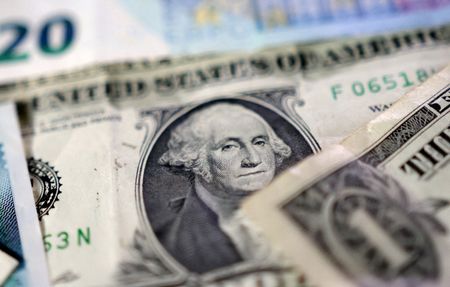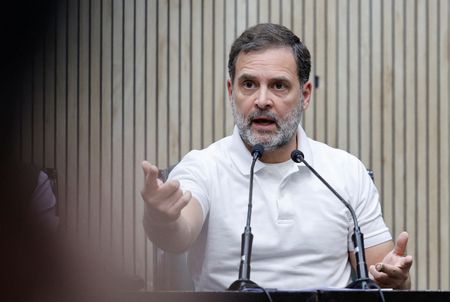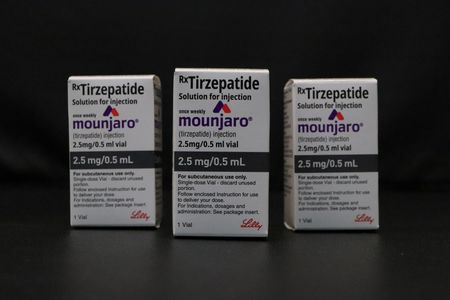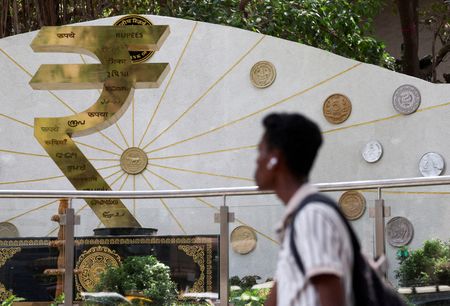By Saqib Iqbal Ahmed and Joice Alves
NEW YORK (Reuters) -The dollar slipped for a second straight session on Wednesday, a day after a U.S. inflation reading increased expectations of a Federal Reserve rate cut next month and renewed pressure from President Donald Trump for lower rates added to the sell-off.
The dollar index, measuring the currency against a basket of peers, fell 0.2% to 97.856, its lowest since July 28, extending its 0.5% drop on Tuesday.
U.S. consumer prices increased marginally in July, data showed on Tuesday, in line with forecasts and as the pass-through from Trump’s sweeping tariffs to goods prices has so far been limited.
Investors priced in near certainty the central bank would ease rates next month, according to LSEG data.
On Wednesday, Treasury Secretary Scott Bessent called for a “series of rate cuts,” and said the Fed could kick off the policy rate easing with a 50 basis point cut.
The day before, U.S. President Donald Trump, who has repeatedly criticised Fed Chair Jerome Powell for not easing rates sooner, had added to the pressure on the Fed.
White House spokeswoman Karoline Leavitt said that the president was considering a lawsuit against Powell in relation to his management of renovations at the central bank’s Washington headquarters.
“I think there is quite significant pressure on the Fed from the political side of Washington to get moving on interest rates,” Shaun Osborne, chief currency strategist at Scotiabank, said.
Michael Pfister, FX analyst at Commerzbank, said these political developments carried echoes of autocratic countries, where heads of statistics agencies or central banks are replaced and critical data series often discontinued or manipulated.
“I’m not saying that this will necessarily happen here. But the developments of the last few days and weeks do not exactly fill me with optimism about the future, or the U.S. dollar,” Pfister said.
Trump also hit out at Goldman Sachs CEO David Solomon, saying the bank had been wrong to predict U.S. tariffs would hurt the economy. Trump questioned whether Solomon should lead the Wall Street institution.
RATE CUT RUMINATIONS
Atlanta Federal Reserve President Raphael Bostic on Wednesday said nearly full U.S. employment offers the central bank the “luxury” of not rushing to make any policy adjustments.
Meanwhile, Chicago Federal Reserve President Austan Goolsbeeon Wednesday said the U.S. central bank is grappling with understanding whether tariffs will push up inflation just temporarily or more persistently.
The dollar’s recent stumble threatens the brief recovery it had made since early July, following a roughly 10% decline in the first half of the year.
“We haven’t seen anywhere near enough strength for the dollar generally to signal a reversal in what is still a pretty significant bear trend,” Scotiabank’s Osborne said.
The dollar’s weakness supported the euro and sterling. The single currency was last up 0.2% to $1.1698, briefly hitting its highest since July 28. Similarly, the British currency rose 0.5% to $1.3567, briefly hitting its highest since July 24.
Britain’s jobs market weakened again, though wage growth stayed strong, according to data on Tuesday, underscoring why the Bank of England is so cautious about cutting interest rates.
The Australian dollar was up 0.2% to $0.6541, while the New Zealand dollar rose 0.3% to $0.5973.
The Reserve Bank of Australia on Tuesday cut interest rates as expected, and signalled further policy easing might be needed to meet its inflation and employment goals as the economy lost some momentum.
In cryptocurrencies, ether rose about 3% to touch a near four-year high of $4,748.77, before paring gains to trade up about 2% at $4,705.67.
(Reporting by Joice Alves and Rae Wee; Editing by Kate Mayberry, Giles Elgood, Barbara Lewis and Cynthia Osterman)










